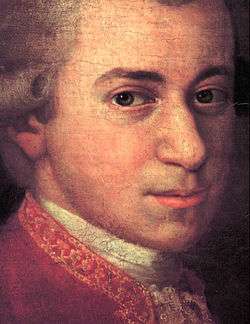Mass in C major, K. 167 "in honorem Sanctissimae Trinitatis"
The Missa in honorem Sanctissimae Trinitatis in C major, K. 167, is a mass composed by Wolfgang Amadeus Mozart in June 1773.[1] It is scored for SATB choir, violin I and II, 2 oboes, 2 clarini (high trumpets), 2 trumpets, timpani and basso continuo.
A solemn mass,[2] its name ("in honour of the Most Holy Trinity") and date indicate that it was likely to have been composed for Trinity Sunday, for use in Salzburg's Trinity Church.[3] This is Mozart's only wholly choral mass setting, excluding all solo vocalists.[3][4] Einstein contends that this may have been done in order to achieve brevity, following the directive of Archbishop Colloredo.[5]
The work consists of six movements. Performances require approximately 25–30 minutes.
- "Kyrie" Allegro, C major, common time
- "Gloria" Allegro, C major, 3/4
- "Credo" Allegro, C major, common time
- "Et incarnatus est..." Adagio, C major, common time
- "Et resurrexit..." Allegro, C major, common time
- "Et in Spiritum Sanctum..." Allegro, G major, 3/4
- "Et unam sanctam..." Allegro, C major, common time
- "Et vitam venturi saeculi..." Alla breve, C major, cut common time
- "Sanctus" Andante, C major, 3/4
- "Hosanna in excelsis..." Allegro, C major, common time
- "Benedictus" Allegro, F major, common time
- "Hosanna in excelsis..." Allegro, C major, common time
- "Agnus Dei" Adagio, C major, 3/4
- "Dona nobis pacem..." Allegro moderato, C major, cut common time
References
- ↑ Tyson, Alan (1987). Mozart: Studies of the Autograph Scores. p. 19.
- ↑ Eisen, Cliff; Keefe, Simon, eds. (2006). The Cambridge Mozart Encyclopedia. p. 271.
- 1 2 Sadie, Stanley (2006). Mozart: The Early Years 1756–1781. p. 307.
- ↑ Abert, Hermann (1923). Eisen, Cliff, ed. W. A. Mozart. Translated by Stewart Spencer. p. 264.
- ↑ Einstein, Alfred (1945). Mozart: His Character, His Work. p. 332.
External links
- Missa in C, Missa in honorem SS:mae Trinitatis: Score and critical report (German) in the Neue Mozart-Ausgabe
- Free scores of Missa in C major (in honorem Sanctissimae Trinitatis), KV 167 in the Choral Public Domain Library (ChoralWiki)
- Mass in C major, K.167: Scores at the International Music Score Library Project
This article is issued from Wikipedia - version of the 9/22/2016. The text is available under the Creative Commons Attribution/Share Alike but additional terms may apply for the media files.

